YIDONG Technology EMI83AB Tablet PC User Manual Surface Pro and Surface Pro 2 User Guide
Shenzhen YIDONG Technology Co., Ltd. Tablet PC Surface Pro and Surface Pro 2 User Guide
User Manual

USER MANUAL
Ava Book 1
Please read the user guide carefully before using

1
Windows10 Quick Guide
What's new
Windows 10 is full of new features and improvements. Take a look at the
highlights!
Ready, set, Start menu
The Start menu is back—and it’s more personal, more organized, and more
fun than before.
Go to Start on the taskbar. You'll find your most used apps on the right of
menu, the All apps list, and shortcuts to other locations on your PC, like File
Explorer and Settings.
Get apps, music, and more
The Store is a one-stop shop for music, videos, games, and apps.
Try out an app before you buy it, or pick a free one. Your Windows 10 apps
will work on all your Windows 10 devices.
Cortana can get it done
Cortana, your digital personal assistant, is right on your desktop. Ask Cortana
to set up a meeting or send an email to a friend—even find your files for you
and tell you jokes. Select the search box and type what you want Cortana to
do, or just select the microphone to talk with Cortana instead.
Rule the web with Microsoft Edge
Microsoft Edge is the first browser that lets you take notes, write, doodle, and
highlight directly on webpages. Use the reading list to save your favorite
articles for later, then read them in reading view . Plus, Cortana is built in to
Microsoft Edge to help you do things faster and easier.
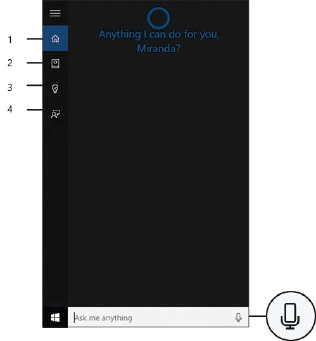
2
Where you can type, you can write
Microsoft Edge isn't the only app you can write in. Use your stylus, finger, or
mouse to write anywhere you can type. Or just doodle in OneNote!
All your photos in one place
No more endless searching. The Photos app collects all your photos and
videos in one place. From your phone, and your PC, and OneDrive. Then, it
organizes your memories into albums for you to enjoy and share.
Search for anything, anywhere
Search your PC and the web from the taskbar to find help, apps, files,
settings—you name it. Your personal assistant Cortana will be your guide.
Cortana is your clever new personal assistant.
Cortana will help you find things on your PC, manage your calendar, track
packages, find files, chat with you, and tell jokes. The more you use Cortana,
the more personalized your
experience will be.
To get started, type a question in the
search box on the taskbar. Or select
the microphone icon and talk to
Cortana. (Typing works for all types
of PCs, but you need a mic to talk.)

3
Hey Cortana!
Set Cortana to hear you anytime you say "Hey Cortana." Select the search
box on the taskbar to open Cortana home. Then select
Notebook > Settings and turn on Let Cortana respond when you say "Hey
Cortana."
Note:
Cortana is only available in certain countries/regions, and some Cortana
features might not be available everywhere. If Cortana isn't available or is
turned off, you can still use search.
Sign in with a Microsoft account
If you signed in with your Microsoft account when you set up Windows,
hooray!
If not, that's OK—you can sign in any time. And if you're not quite sure what a
Microsoft account is, read on.
How to sign in
1.Go to Start , then select Settings > Accounts > Your account.
2.Select Sign in with a Microsoft account instead.
3.Follow the prompts to switch to a Microsoft account. You may need to verify
your identity by entering a confirmation code.
Your local account will switch to your Microsoft account. The next time you
sign in to Windows, use your Microsoft account name and password. Your
apps and files will not be affected.
Set up accounts
If you plan to share your PC with other people, consider adding accounts for
them. It's always nice to share, and that way your friends will have some
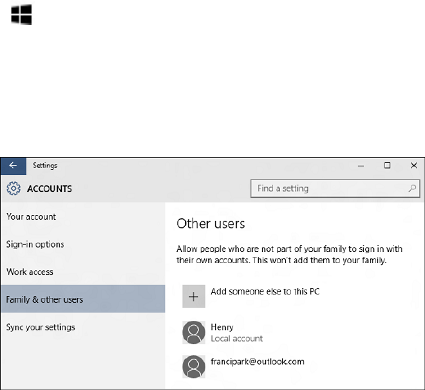
4
personal space—including separate files, browser favorites, and a desktop
they can call their own.
Add an account
1.Go to Start , then select Settings > Accounts > Your account.
2.Select Family & other users (or Other users, if you’re using Windows 10
Enterprise).
3.Under Other users, select Add someone else to this PC.
Note:
1.If the person you’re adding has a Microsoft account, enter their email
address, select Next, and then select Finish. After they sign in, their online
email, photos, files, and settings will be waiting for them.
2.If the person you’re adding doesn’t have a Microsoft account, select Sign in
without a Microsoft account (it's OK that it says "not recommended"), and
then select Local account. Set their user name, temporary password, and
password hint, and then select Next > Finish.
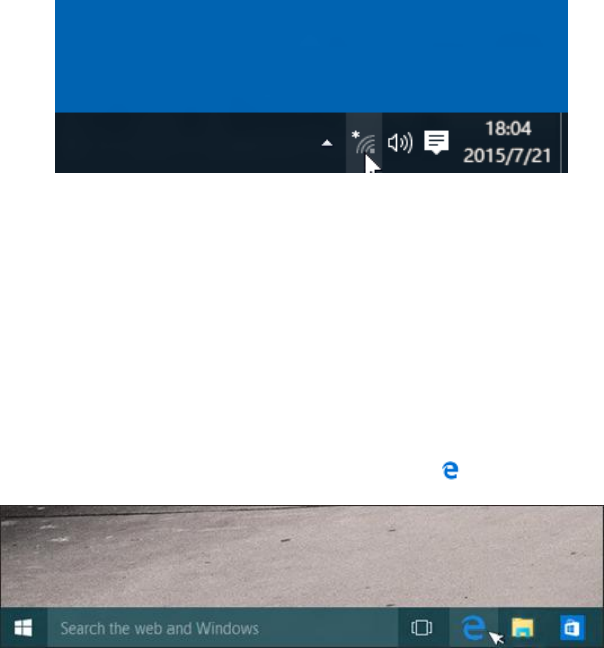
5
Get online
To connect to a Wi-Fi network, select the Wi-Fi network icon on the taskbar.
Select the network you want > Connect, then enter the password and follow
the instructions. That's it—you're connected! This icon will appear in the
taskbar.
If Wi-Fi isn't available, or you just want the assurance of a wired connection,
the Ethernet cable is your friend—just connect your PC to your router or
modem, and then do your thing.
Get to know Microsoft Edge
Welcome to the latest way to surf the web! Microsoft Edge gives you new
ways to find stuff, read—and write—on the web, plus help from Cortana
where you need it. To get going, select Microsoft Edge on the taskbar.
Hub: all your stuff in one place
Think of the Hub as the place where Microsoft Edge keeps the things you
collect on the web. Select Hub to view your favorites, reading list, browsing
history, and current downloads.
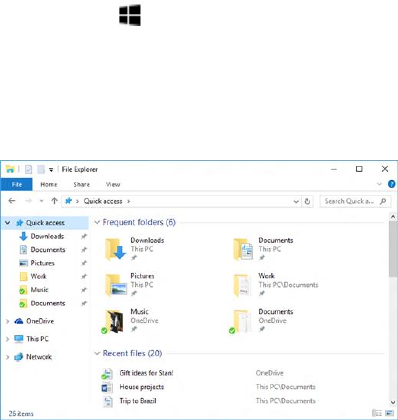
6
Looking for your favorites? In the Hub, choose Favorites and then
select Import favorites.
Search faster from the address bar
No need to go to a website to search for pictures of adorable penguins. Stay
put and save time by entering your search in the handy address bar. You’ll get
search suggestions, instant results from the web, and your browsing history
right on the spot.
Find your files
To see all the files on your PC, select the File Explorer icon on the taskbar or
press the Windows logo key + E on your keyboard.
Get to files faster
When File Explorer opens, you’ll land in Quick access. This is place to find
files you’ve been working on and you often use.
Here are a few ways to customize Quick access:
⦁ Pin a folder there so it's always close at hand. Right-click (or press and hold)
the folder and then select Pin to Quick access.

7
⦁ Remove a file or folder from Quick access (like that list of birthday gifts for
Stan). Just right-click it and select Remove from Quick access. It won’t
show up there again, even if you use it every day.
⦁ Turn off recent files and frequent folders, so only your pinned folders show
up in Quick access. Select View > Options, then, under Privacy, clear the
check boxes and select Apply. (If you turn them back on later, any items you
removed from Quick access—like Stan's gift list—might show up there
again.)
Backup and restore your files
It's always good to have a backup. Keep copies of your files on another drive
in case something happens to the originals.
Set up your backup
Go to Start , then select Settings > Update & security > Backup > Add a
drive and choose an external drive or network location for your backups.
All set. Every hour, we’ll back up everything in your user folder
(C:\Users\username). To change which files get backed up or how often
backups happen, go to More options.
Restore your files
If you’re missing an important file or folder, here’s how to get it back:
1.Search for Restore files from the taskbar and select Restore your files with
File History.
2.Look for the file you need and then use the arrows to see all its versions.
3.When you find the version you want, select the Restore button to save it in
its original location. To save it in a different place, right-click (or press and
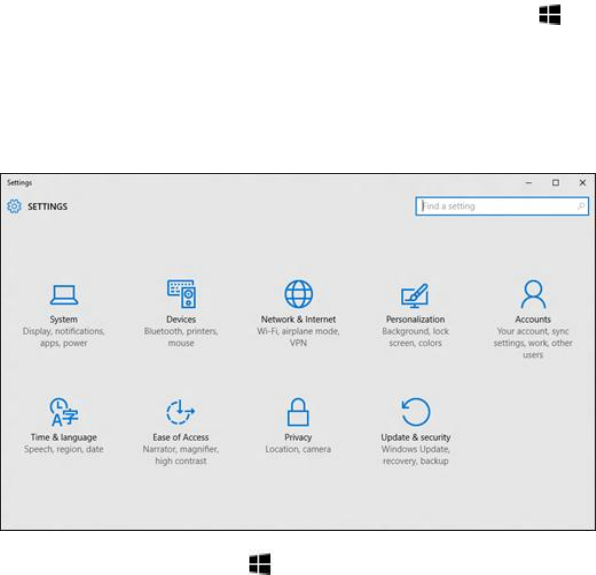
8
hold) the Restore button, select Restore to, and then choose a new
location.
Make Start full screen
To make Start full screen and see everything in one view, go to Start ,
then Settings > Personalization > Start, and then turn on Use Start full screen.
A new look for settings
Settings got a makeover—and dropped "PC" from its name.
Get to Settings by going to Start > Settings. From there, browse the
categories or use search to find what you're looking for, including advanced
options in Control Panel.
Most apps have their own settings—look for this icon in the app.
Tip: Change common settings (like airplane mode and Wi-Fi) on the fly
from action center on the taskbar.
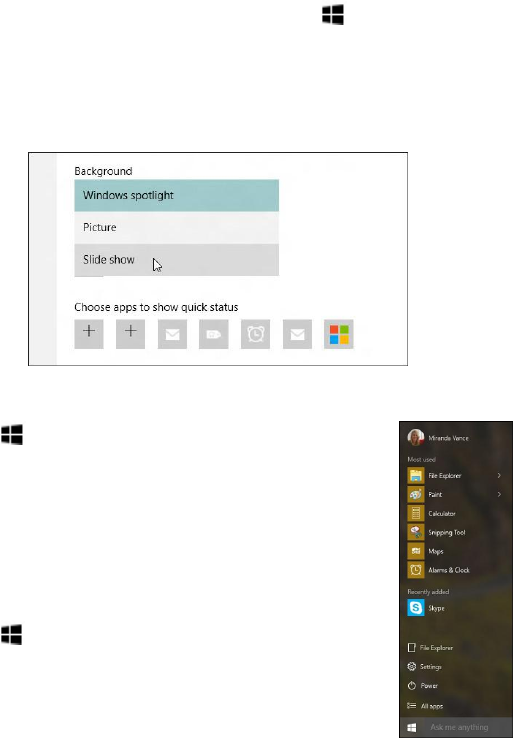
9
Personalize your lock screen
To tweak your lock screen to your liking, go to Start ,
then Settings > Personalization > Lock screen. Try changing the background
to a favorite photo or slide show, or choose any combination of detailed and
quick status notifications to show you upcoming calendar events, social
network updates, and other app and system notifications.
Get started with themes
Go to Start ,
then Settings > Personalization > Themes and
select Theme settings. Then choose from a default theme,
or select Get more themes online to download new themes
featuring cute critters, holiday cheer, and other
smile-inducing options.
Change desktop background and colors
Go to Start , then Settings > Personalization to choose a
picture worthy of gracing your desktop background, and to
change the accent color for Start, the taskbar, and other
items. The preview window gives you a sneak peek of your
changes as you make them.
In Background, select a picture, solid color, or create a slide show of pictures.
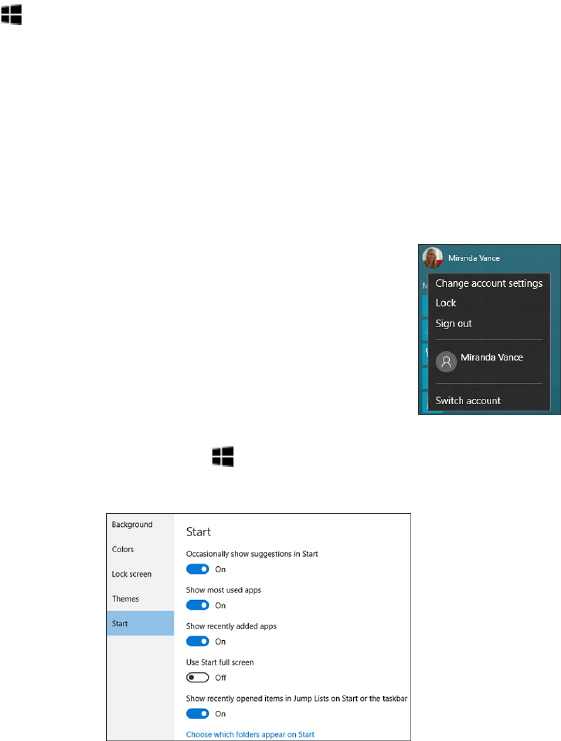
10
See what's on the menu
The Start menu is back and better than ever! Just select the Start
button on the taskbar. Next, make it yours by pinning apps and programs,
or moving and regrouping tiles. If you need more space, resize the Start
menu to make it bigger.
Your apps and programs—right at your fingertips
Get to File Explorer, Settings, and other apps you use often from the left side
of the Start menu. To see all your apps and programs, select All apps
You have the power
Lock or sign out of your PC, switch to another account, or
change your account picture by selecting your name at
the top of the Start menu.
And when you're ready to step away for a while, the
power button is right there at the bottom of the Start
menu so you can put your PC to sleep, restart it, or turn it
off completely.
If you want to make other changes to how the Start menu looks, you can do so
in Settings. Open the Start menu , then go
toSettings > Personalization > Start to change which apps and folders appear
in the Start menu.

11
Explore the Store
Windows 10 comes with great built-in apps including Skype and OneDrive,
but that’s just the beginning. The Store has tons more to help you stay in
touch and get things done, plus more games and entertainment than ever
before—many free!
To find the Store, go to Start , and then select Store or select it from the
taskbar. (You’ll need an Internet connection and a Microsoft account.) Use
Search to quickly find what you’re looking for, or browse top charts, categories,
and custom collections.
When you find something you want, choose it and then select Free if it’s free,
the price or Try, if it’s a paid app. Buy once, enjoy anywhere, on any
compatible device—phone, laptop, desktop, or Xbox.
Move apps around
To see several apps at the same time, grab the top of the window of one app
and drag it to the side or corner of the screen. You'll see where the app will
snap, along with other apps that can automatically snap next to it. Select Task
view on the taskbar to quickly switch between open apps.
Group apps into desktops
Group apps together for whatever you want by creating virtual desktops.
Select Task view on the taskbar, then New desktop, then open the apps you
need.
To move apps between virtual desktops, select Task view, and then drag the
app you want from one desktop to another. Or create another virtual desktop
by dragging an app to New desktop.
Take action instantly
Action center puts important notifications from Windows and your apps right
on the taskbar, along with quick actions, which get you to your most-used
settings and apps instantly.
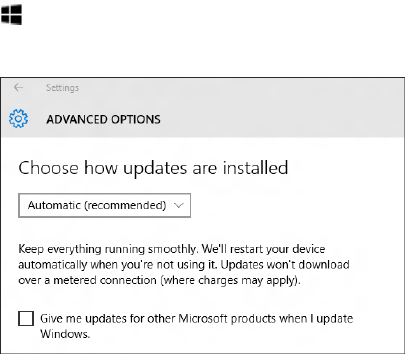
12
To see your notifications and quick actions, select the action center icon on
the taskbar. (You can also swipe in from the right edge of your screen, or
press Windows logo key+A.)
Choose how updates are installed
New features and a better running PC—get all of this and more when you
download updates to Windows.
And the great news is that you don’t have to do anything, because updates
will be automatically downloaded and installed whenever they’re available.
(Unless you’re on a metered connection, in which case the updates won’t
download until you opt to get them.)
But every now and then your PC may need to restart to install the updates. To
prevent those restarts from happening at the most inconvenient time:
1.Go to Start , then Settings > Update & security > Windows Update , and
then select Advanced options.
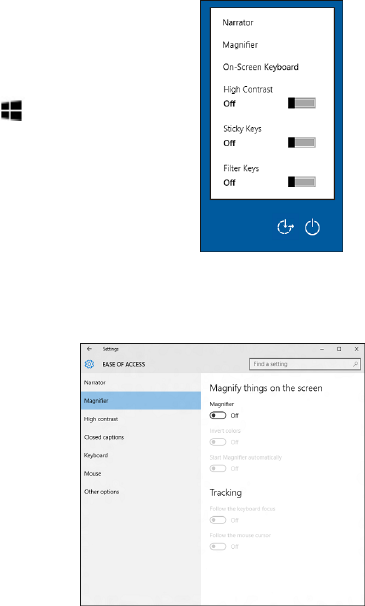
13
2.Under Choose how updates are installed, use the drop-down menu to
choose an option:
⦁ Schedule a restart
⦁ Automatically restart
Make your PC easier to use
Setting up your PC to make it more accessible takes
only a few steps. Most Ease of Access options are
available in Settings. Go to Start and
select Settings > Ease of Access .
Commonly used options are also available from the
sign-in screen. Select the Ease of Access button in the
lower-right corner to see them.
Ease of Access options can help make it easier to:
⦁ Use your PC without a display. Narrator lets you hear audio descriptions for
elements on the screen, like text and
buttons.
⦁ See what's on the screen. Make the
content on your screen bigger using
Magnifier, or use high contrast mode.
⦁ Use your mouse. Change the pointer
size, or turn on Mouse Keys to use
your keypad to move the mouse.

14
Use Speech Recognition
Windows Speech Recognition lets you control your PC with your voice alone,
without needing a keyboard or mouse. There's a wizard to help you get
started. Just plug in your microphone, and then, in the search box on the
taskbar, enter Speech Recognition, and select Windows Speech Recognition.
After you complete the wizard, you can walk through a tutorial to learn voice
commands and train your PC to recognize your voice.
For additional options, enter Control Panel in the search box on the taskbar,
and select Control Panel. Then select Ease of Access > Speech Recognition.
This is just a sample of the new shortcuts in Windows—to see them all, have a
look at new keyboard shortcuts.
For more information please visit the Mircosoft Website:
http://www.microsoft.com.
For Shairlook support please visit www.shairlook.com and use our live chat
feature Mon-Fri 9AM – 6PM EST.
Credits:
Microsoft and Windows are either registered trademarks or trademarks of
Microsoft Corporation in the United States and/or other countries.
Shairlook is a registered trademark of Shairlook LLC
FCC Statement
This equipment has been tested and found to comply with the limits for
a Class B digital device, pursuant to Part 15 of the FCC Rules. These
limits are designed to provide reasonable protection against harmful
interference in a residential installation. This equipment generates uses
and can radiate radio frequency energy and, if not installed and used in
accordance with the instructions, may cause harmful interference to
radio communications. However, there is no guarantee that
interference will not occur in a particular installation. If this equipment
does cause harmful interference to radio or television reception, which
can be determined by turning the equipment off and on, the user is
encouraged to try to correct the interference by one or more of the
following measures:
-- Reorient or relocate the receiving antenna.
-- Increase the separation between the equipment and receiver.
-- Connect the equipment into an outlet on a circuit different from that
to which the receiver is connected.
-- Consult the dealer or an experienced radio/TV technician for help.
This device complies with part 15 of the FCC Rules. Operation is
subject to the following two conditions:
(1) This device may not cause harmful interference, and (2) this device
must accept any interference received, including interference that may
cause undesired operation.
Changes or modifications not expressly approved by the party
responsible for compliance could void the user's authority to operate
the equipment.